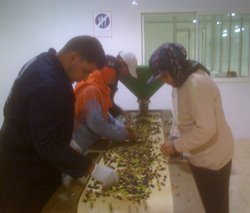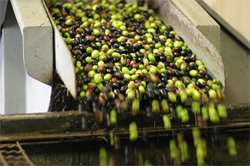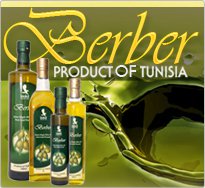Home > EOO PRODUCTION > Grinding
Grinding
Before the grinding process begins, the separation of the olives from the accompanying leaves, twigs, etc takes place and then the olives are transferred to a washing machine where they are vigorously washed using an air and water mixture.
The well ripened olives are grinded into a paste using our modern two faced mill. After the grinding, the olive paste is spread on a series of disks, which are then stacked one on top of the other in a column, then placed into the olive press. After pressure is applied onto the column to separate the liquid from the paste, the liquid still has a large water content. Traditionally the oil was separated from water using a simple gravity method, after all everyone knows that oil and water do not mix. To speed up this process, modern presses use a centrifuge. The centrifuge has one exit for the water part of the oil blend and one specific exit point for the oil.
The grinding process at our modern steel drum mill takes about 20 minutes. After the grinding, the olive paste is stirred for an additional 20-30 minutes in a container where the microscopic oil drops form themselves into even larger “blobs” of oil, naturally separating it from any water present in the mix.
Malaxation
From the grinder, the paste goes into a tank for malaxation. In this process, the olive paste is stirred slowly with paddles to help reverse the homogenization that takes place during grinding. The small droplets of oil are coaxed together into larger droplets to help the separation process. Malaxation usually takes from 30-45 minutes, depending on the character of the paste. During the grinding and malaxation stages the action of fruit enzymes gives each olive oil its particular aroma.
Separation
After the process of malaxation is finished the olive paste is pumped into a decanter centrifuge. The centrifuge rotates approximately at 3000 rpm, separating the three phases of solids, vegetation water, and olive oil via their different densities. There is also a coil within the centrifuge that rotates at a few rpm slower and pushes the solid materials out of the system.
Decanter
In a decanter, separation that takes hours with just gravity is done in seconds. The olive paste is spun at high speed to separate the different parts: solids (heaviest), fruit water and olive oil (lightest). The olive oil is pulled out of the decanter and sent for a final cleaning in the vertical separator. The final cleaning of the olive oil is sometimes called polishing. This process involves another centrifuging, this time in a modified cream separator. The last traces of fruit water and particles are removed and the fresh olive oil is ready for settling or filtration. At the end of the extraction process, the first cold press extra virgin olive oil leaves the machine and is collected in a large steel container, from which containers for each participating olive growers are filled.
 |  |
The well ripened olives are grinded into a paste using our modern two faced mill. After the grinding, the olive paste is spread on a series of disks, which are then stacked one on top of the other in a column, then placed into the olive press. After pressure is applied onto the column to separate the liquid from the paste, the liquid still has a large water content. Traditionally the oil was separated from water using a simple gravity method, after all everyone knows that oil and water do not mix. To speed up this process, modern presses use a centrifuge. The centrifuge has one exit for the water part of the oil blend and one specific exit point for the oil.
The grinding process at our modern steel drum mill takes about 20 minutes. After the grinding, the olive paste is stirred for an additional 20-30 minutes in a container where the microscopic oil drops form themselves into even larger “blobs” of oil, naturally separating it from any water present in the mix.
Malaxation
From the grinder, the paste goes into a tank for malaxation. In this process, the olive paste is stirred slowly with paddles to help reverse the homogenization that takes place during grinding. The small droplets of oil are coaxed together into larger droplets to help the separation process. Malaxation usually takes from 30-45 minutes, depending on the character of the paste. During the grinding and malaxation stages the action of fruit enzymes gives each olive oil its particular aroma.
Separation
After the process of malaxation is finished the olive paste is pumped into a decanter centrifuge. The centrifuge rotates approximately at 3000 rpm, separating the three phases of solids, vegetation water, and olive oil via their different densities. There is also a coil within the centrifuge that rotates at a few rpm slower and pushes the solid materials out of the system.
Decanter
In a decanter, separation that takes hours with just gravity is done in seconds. The olive paste is spun at high speed to separate the different parts: solids (heaviest), fruit water and olive oil (lightest). The olive oil is pulled out of the decanter and sent for a final cleaning in the vertical separator. The final cleaning of the olive oil is sometimes called polishing. This process involves another centrifuging, this time in a modified cream separator. The last traces of fruit water and particles are removed and the fresh olive oil is ready for settling or filtration. At the end of the extraction process, the first cold press extra virgin olive oil leaves the machine and is collected in a large steel container, from which containers for each participating olive growers are filled.





